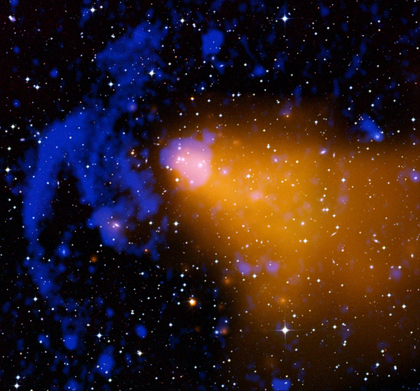B
BoJangles2
Guest
Further proof or disproof for dark matter
I guess there would be an easy formula to calculate whether the apparent mass and velocity of 2 or more galaxies (without the added mass of dark matter) should be interacting using general relativity, i.e. there would seem to be a cut off point where 2 galaxies and their particulars just won’t significantly interact to keep them bound.
At that point would the effect of the dark energy outweigh the affects of dark matter (i.e. extra mass), and if not, would that help calculate the extra mass/energy needed to keep seemingly interacting galaxies/clusters together, and does this discrepancy if found equal the mass a galaxy needs to keep its rotation curve as eluded to with dark matter.
Forgive me if this sounds a little disjointed, as this has been scrawled together.
Ill try and refine this a bit more.
If we look at any 2 galaxies or cluster of galaxies, calculate the apparent mass of each individual galaxy, (i.e. the mass we can calculate from what we see), use some GR and plot their course, then compare it against what the theoretical mass needed for dark matter to keep each galaxies rotation curve, we should be able to find fringe cases which either do fit or don’t fit the added weight of dark matter, fully dependent on whether dark energy is playing a significant role at this distance.
I’m sure this has been done in every 1st year cosmology class, however id like to see if the results fit perfectly, i.e. is everything in equilibrium as far as our current theories go with DM, DE, interacting galaxies, and a galaxies rotation curve.
I guess there would be an easy formula to calculate whether the apparent mass and velocity of 2 or more galaxies (without the added mass of dark matter) should be interacting using general relativity, i.e. there would seem to be a cut off point where 2 galaxies and their particulars just won’t significantly interact to keep them bound.
At that point would the effect of the dark energy outweigh the affects of dark matter (i.e. extra mass), and if not, would that help calculate the extra mass/energy needed to keep seemingly interacting galaxies/clusters together, and does this discrepancy if found equal the mass a galaxy needs to keep its rotation curve as eluded to with dark matter.
Forgive me if this sounds a little disjointed, as this has been scrawled together.
Ill try and refine this a bit more.
If we look at any 2 galaxies or cluster of galaxies, calculate the apparent mass of each individual galaxy, (i.e. the mass we can calculate from what we see), use some GR and plot their course, then compare it against what the theoretical mass needed for dark matter to keep each galaxies rotation curve, we should be able to find fringe cases which either do fit or don’t fit the added weight of dark matter, fully dependent on whether dark energy is playing a significant role at this distance.
I’m sure this has been done in every 1st year cosmology class, however id like to see if the results fit perfectly, i.e. is everything in equilibrium as far as our current theories go with DM, DE, interacting galaxies, and a galaxies rotation curve.





